Papua - region of Eastern Indonesia on the island of New Guinea
For other places with the same name, see Papua (disambiguation).
This Wikivoyage region covers the entire Indonesian half of the island of New Guinea.
Papua, also known as Western New Guinea and formerly Irian Jaya, is the easternmost part of Indonesia. It comprises the western half of the island of New Guinea, the world's largest and highest tropical island, while the eastern half is the independent country of Papua New Guinea.
Papua retains many traditional cultures and is home to some of the richest biodiversity in the world. Lorentz National Park, a UNESCO World Heritage Site and the largest protected area in the Asia-Pacific region, ranges from Papua's southwest coast to its central mountains.
Cities
- Biak — an island in the pacific ocean
- Fakfak — the only town in West Papua with a significant Arab-Papuan presence
- Jayapura — the capital and largest city
- Manokwari — the capital city of West Papua
- Merauke — gateway to the most eastern point of Indonesia
- Sorong — the largest port city in bird’s head peninsula
- Timika — staging post for one of the world's largest mines
- Wamena — gateway to the Baliem Valley
Other destinations
- Baliem Valley — the home of the famous penis-gourded Dani warriors
- Lorentz National Park — the largest national park in Asia
- Raja Ampat — home of the world's richest reefs
- Asmat — home of the world-renowned Asmat woodcarvers
Understand
Papua consists of the six provinces of Papua (the traditional name is Tabi Saireri), Central Papua (Mee Pago), Highland Papua (La Pago), South Papua (Anim Ha), West Papua (Bomberai), and Southwest Papua (Domberai) in Indonesia.
History
Like the rest of Indonesia, West Papua was part of the Dutch East Indies before World War II. However, after Indonesian independence, the region remained under Dutch rule for some time. Elections were held in the territory in 1959 and an elected council took office in 1961, in preparation for full independence from the Dutch. However, the Dutch handed the area over to a UN temporary administration, who in turned gave it over to Indonesia in 1963. A controversial plebiscite known as the Act of Free Choice, held in 1969, resulted in an improbable 100% vote in favor of joining Indonesia. The region, renamed first as Irian Barat (West Irian) and then Irian Jaya (Glorious Irian) has been under heavy Indonesian military control ever since, with the outgunned Free Papua Movement (Operasi Papua Merdeka or OPM) fighting for independence.
The name Papua was restored in 2000 in a sop to the nationalists. The province was split into two in 2003 in a very controversial move, with the Bird's Head Peninsula and surrounding islands becoming West Papua (Papua Barat). A further split occurred in 2022, to create some new provinces, Central Papua province, Highland Papua province, South Papua province, and Southwest Papua province.
Culture
Comprising the western half of the island of New Guinea, the world's largest and highest tropical island, Papua is incredibly diverse and different from the rest of Indonesia (or, for that matter, anywhere else in the world). Despite of a population of under five million, Papua is home to over 250 languages and retains many traditional cultures that were until very recently "still in the Stone Age". Cannibalism and headhunting were practiced in some areas until the 1970s. Papua is a stronghold of Christianity, so many non-halal ingredients are used extensively in the local cuisine.
Terrain and ecology

A vital tropical rainforest with the tallest tropical trees and vast biodiversity, Papua's known forest fauna includes marsupials (including possums, wallabies, tree-kangaroos, and cuscuses), other mammals (including the endangered long-beaked Echidna), many bird species (including birds of paradise, cassowaries, parrots, cockatoos), the world's longest lizards (Papua monitor) and the world's largest butterflies. The island has an estimated 16,000 species of plant, 124 genera of which are endemic.
The extensive waterways and wetlands of Papua are also home to salt and freshwater crocodile.
The interior of Papua is home to some of Indonesia's highest mountains, including snow-capped ones.
Large parts of the equatorial glacier fields in the highlands remain largely unexplored. Protected areas within Papua province include the Lorentz National Park, a UNESCO World Heritage Site, and the Wasur National Park, a RAMSAR wetland of international importance.
Events
Papua holds numerous events each year. Some of its famous festivals and events include the Festival Budaya Asmat, the Festival Danau Sentani, the Festival Lembah Baliem, the Festival Kamoro, and the Festival Teluk Humboldt.
Get in
 Travel permits (surat jalan) are required for all travel in Papua beyond the main coastal towns. The list changes randomly, but Jayapura and Biak are generally permit-free, and Sentani, Manokwari and Sorong are usually fine. Permits are most easily acquired in Jayapura and Biak, where they're usually obtainable in one day, although they are usually available in the other non-permit towns as well. Two passport photos and a token administration fee (Rp5,000 or so) are required.
Travel permits (surat jalan) are required for all travel in Papua beyond the main coastal towns. The list changes randomly, but Jayapura and Biak are generally permit-free, and Sentani, Manokwari and Sorong are usually fine. Permits are most easily acquired in Jayapura and Biak, where they're usually obtainable in one day, although they are usually available in the other non-permit towns as well. Two passport photos and a token administration fee (Rp5,000 or so) are required.
The permit must list all the places you're planning to visit, no changes are allowed unless you get a new one in the main town. Whenever you arrive in a new town in Papua, you have to get your permit stamped at the police station. Make lots of copies, you'll need them for hotels and such.
Despite the claims of some embassies to the contrary, no permits are required for the travel to Papua. It's best not to mention Papua at all when applying for a visa.
By plane
Although Papua can be accessed either by water or air, almost all travellers travel by air. The main gateway is Sentani Airport in Jayapura (IATA: DJJ), but there are also frequent flights from some major Indonesian cities to Biak (IATA: BIK), Manokwari (IATA: MKW), Sorong (IATA: SOQ) and Timika (IATA: TIM). There are some direct flights to Papua from Jakarta, but for most destinations and carriers a stopover is necessary, usually in Makassar.
Wamena Airport (IATA: WMX) to the Baliem Valley.
By boat
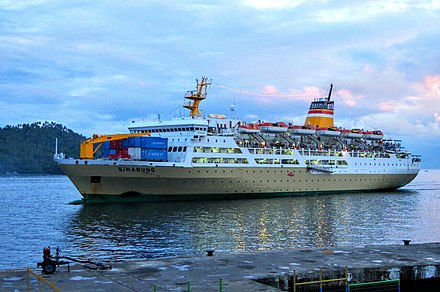 PT. Pelayaran Nasional Indonesia (PELNI) operates boat services from other parts of Indonesia and within Papua, with serviced places on the island including Biak, Serui, Nabire, Sorong, Fakfak, Timika and Merauke. (Reports indicate it takes approximately 2 weeks from Jakarta to Jayapura; it takes 2½ days from Jayapura to Nabire)
PT. Pelayaran Nasional Indonesia (PELNI) operates boat services from other parts of Indonesia and within Papua, with serviced places on the island including Biak, Serui, Nabire, Sorong, Fakfak, Timika and Merauke. (Reports indicate it takes approximately 2 weeks from Jakarta to Jayapura; it takes 2½ days from Jayapura to Nabire)
PELNI boats KM. Sinabung from Surabaya stop at Jayapura, Sorong, Manokwari and Biak. This is a relaxing and interesting way to arrive if you have the time. PELNI provides a 3-class service, consisting roughly of economy, second class, and first class. Economy class lodging and service provides for a 2.5 x 7ft bed arranged side-by-side with other beds and comes with minimal meals and sanitary facilities (public bathroom). The second class service consists of a 4-bed room with basic meal services and a small private bathroom. First class service is nearly identical to second class, except that the room features a 2-bed room and a window for a view outside.
Each ship also features a mini-movie theater, and restaurant (for those who prefer to eat something more than the provided meals).
By land
The land border crossing between Papua and Papua New Guinea open to foreigners is on the north coast between Jayapura and Vanimo, PNG. Also, on the south side, there is a border post between Merauke and Wereave, PNG. There is no public transport across, so car or motorbike hire for some of the distance is required. Advance visas are required.
Get around
Most of Papua's main cities are not connected by road, but Trans Papua Sorong-Manokwari-Bintuni with almost 600 km length has been finished (the other sections of Trans Papua are being built). Cars can drive easily along the route but should bring tools to fix breakdowns and carry sufficient fuel. State-owned bus company, DAMRI serves some cities including Biak, Jayapura, Manokwari, Mimika, Nabire, Sarmi and Sorong. Flying is a practical option for covering longer distances. Boat charter for river travel is surprisingly expensive, the price going from USD50/day for a simple canoe to a whopping USD500/day (including gas) for a motorised outboard, but the price is downward gradually, because the subsidised fuel price nowadays is same in all over Indonesia since 2017. The problem in Papua is there are only limited formal fuel pumps, but private fuel vendors are available.
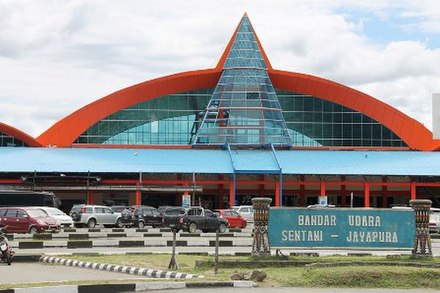 Since most cities which are scattered across the island, usually almost all travel within the Papua region is done by air. Big airlines such as Garuda, Sriwijaya and Wings Air (a subsidiary of Lion Air) hop between major cities in Papua. Smaller airlines including Trigana Air Service, Aviastar, Nusantara, Susi Air, and quite a few others do regional hops. Special charter flights to one of the more than 300 very remote villages can be scheduled with charter airlines such as Susi Air and Mimika Air or with flight organisations such as Associated Mission Aviation (AMA), based in Jayapura. If you are very lucky, you might be able to catch a cargo plane ride (no seat belts!) from Wamena in the Baliem Valley to Jayapura for a mere Rp50,000-100,000. But for safety, Wings Air and Trigana Air Service have scheduled flights between those two cities.
Since most cities which are scattered across the island, usually almost all travel within the Papua region is done by air. Big airlines such as Garuda, Sriwijaya and Wings Air (a subsidiary of Lion Air) hop between major cities in Papua. Smaller airlines including Trigana Air Service, Aviastar, Nusantara, Susi Air, and quite a few others do regional hops. Special charter flights to one of the more than 300 very remote villages can be scheduled with charter airlines such as Susi Air and Mimika Air or with flight organisations such as Associated Mission Aviation (AMA), based in Jayapura. If you are very lucky, you might be able to catch a cargo plane ride (no seat belts!) from Wamena in the Baliem Valley to Jayapura for a mere Rp50,000-100,000. But for safety, Wings Air and Trigana Air Service have scheduled flights between those two cities.
- Susi Air to local destinations across Papua. +62 811 211 3080
- Trigana Air. +62 967 535 666
- Lion Air provides budget flights to and from various parts of Indonesia, and regional flights between major cities in Papua. +6280 4177 8899
See

- See Australasian wildlife in the national park or conservation area including birds-of-paradise, cassowary, crowned pigeon, dingiso, dorcopsis, pig-nosed turtle, tree-kangaroo, waigeou cuscus, and so on.
- A total solar eclipse will be visible on 20 April 2023, if you're very lucky - it's the wet season and viewing prospects are at best 10%. The track heads northeast over the top end of the "bird's tail", south of Bintuni Bay dividing the tail from the Bird's Head Peninsula. It crosses the isthmus or bird's neck at Modan, total from 13:48 local time (04:48 UTC) and lasting 64 seconds. This is the only part of Indonesia with a total eclipse; the track also crosses East Timor but misses West Timor.
- Traditional houses of Papuan people, Honai, the traditional houses of the mountains Papuan, especially the Dani tribe. Rumah Tinggi of Korowai tribe, built on large and sturdy trees as the basis for the foundation. The tops of the trees are then deforested for further use as houses. All materials are of natural origin, logs and boards are used for the roof and floors, while the walls are made of sago bark and wide leaves. Jew, one of the traditional houses from the Asmat tribe.
- Mumi Papua (Papuan mummy), the mummification is done by fumigating the corpse with firewood. There are five tribes in Papua that have a tradition of mummifying corpses, including the Mek tribe in the Pegunungan Bintang, the Dani tribe in the Baliem Valley, the Moni tribe in Intan Jaya, the Yali tribe in Kurima, and the Mee tribe in Dogiyai.
- Historical sites, there are so many historical relics from the Dutch colonial era to the second world war in Papua, Fort Du Bus in Kaimana Regency, MacArthur Monument in Jayapura Regency, Boven-Digoel concentration camp near Merauke, World War II Monument in Biak, etc.
- Prehistoric sites in Tutari, Jayapura Regency. The Tutari site is a rising hill overgrown with weeds, shrubs, and eucalyptus trees and there are large rocks. Some of the stones were used as a medium for megalithic paintings. Also in Fakfak Regency, there are numerous prehistoric sites in Tapurarang Kokas, there are red palms painted on cliff walls and caves.
- 0 kilometres of Indonesia monument in Merauke, which is the most eastern point of Indonesia.
- Grasberg mine. There is a mine tour conducted by PT Freeport Indonesia. You also have the opportunity to ride a large gondola through the fog. Don't forget to stop by Kuala Kencana, the first city in Indonesia to use underground utilities for power lines, and communications, as well as distribution of clean water and centralized sewage treatment.
Natural sights
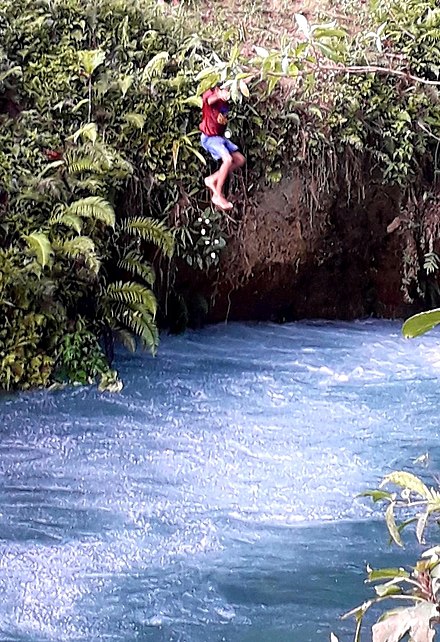
- Beaches, various white sand beaches can be found in Raja Ampat, Biak, Fakfak and Manokwari.
- Clean and clear rivers, visiting and swimming in the river Kali Biru Warsambin in Raja Ampat or Kali Biru Genyem in Jayapura, also Kali Sembra Teminabuan in Sorong.
- Lakes, you may see blue water lake, Telaga Biru Samares in Biak and many other beautiful lakes (danau) in Papua including Danau Kamakawalor in Kaimana Regency, Danau Rombebai in Memberamo Raya Regency, Danau Paniai in Paniai Regency, Danau Tigi in Deiyai Regency, and so on.
- Turquoise water bay, fly to Serui in Kepulauan Yapen Regency to see a bay that has turquoise water named Teluk Sarawandori.
- Waterfalls, there are numerous waterfalls in Papua, just ask people, you want to go to the nearest air terjun. You may visit Air Terjun Sasnek in Sorong Selatan Regency and Air Terjun Selani in Keerom Regency.
Do

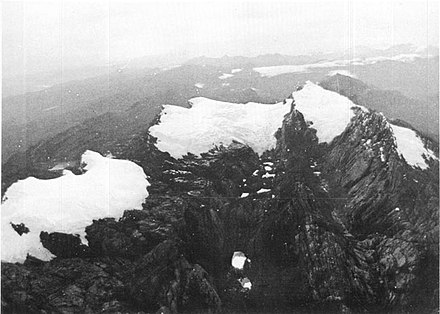
Diving and snorkeling
The archipelago of Raja Ampat, in the waters of the Bird's Head Peninsula in Indonesian Papua, is regarded by Conservation International as the area with the highest marine biodiversity (e. g. 553 species of corals out of the total 798 known species) on earth. Higher than any other areas in the Coral Triangle compound which consists of Papua New Guinea, Indonesia, and the Philippines. It is also insanely off-the-beaten-path which greatly helps to preserve its pristine nature, options to visit the area include staying on a liveaboard or staying in one of the few resort islands Misool, Sorido, or Arborek. In Padaido islands of Biak, you may find an undersea cave, coral garden, and World War II wrecks. In Teluk Cendrawasih National Park in Teluk Wondama Regency, you may dive with whale sharks.
Mountaineering
Puncak Jaya (Carstensz Pyramid) in Lorentz National Park has become a part of the World Seven Summits. In addition, there are several other mountains that can be climbed in Papua including, Puncak Trikora, Puncak Mandala, Puncak Yamin, Mount Cycloop, Mount Bijih, Mount Mebo, Mount Umsini, Mount Kwoka, Mount Yaramniapuka, and others.
Tradition
Wearing a koteka - the traditional Dani dress for men.
Eat
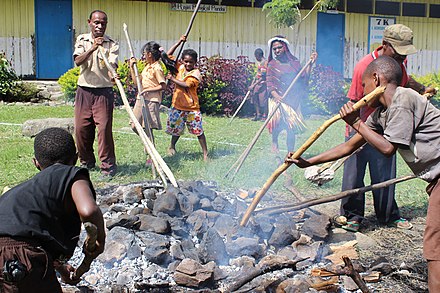 Native highland Papuan food usually consists of boar with tubers such as sweet potato and taro cooked in some hot stones called Barapen or Bakar batu. In lowland and coastal areas, freshwater and marine products are the main food.
Native highland Papuan food usually consists of boar with tubers such as sweet potato and taro cooked in some hot stones called Barapen or Bakar batu. In lowland and coastal areas, freshwater and marine products are the main food.
- Abon gulung. , rolls with abon (floss) in the middle. A delicacy of Manokwari city.
- Aunu Senebre, made from the basic ingredients of teri nasi (Commerson's anchovy) mixed with sliced taro leaves.
- Finukhu/papeda bungkus, one of Indonesia's intangible cultural heritages, sago porridge/congee in banana leaves.
- Ikan bungkus, steamed spiced fish wrapped in taro leaves.
- Keladi tumbuk. boiled taro then pounded until smooth. It is served with ferns, papaya flowers, smoked fish, and sambal.
- Keripik keladi, a sweet and spicy taro chips from Sorong.
- Kue lontar, a condensed milk pie.
- Sagu tindis/amamaihi, a dish made from sago and grated coconut made by the Kamoro people in Timika.
- Sate rusa, a deer satay, specialty of Merauke city.
- Udang selingkuh, a crayfish dish in Baliem Valley. You may try this dish in the city of Wamena.
- Ulat sagu, raw sago caterpillar.
Drink
Alcoholic
- Swansrai, Papuan specialty drinks, especially from the Biak, Supiori, and Numfor regions, which have a strong, slightly bitter taste, and alcohol content of up to 30 percent. Similar drinks are also found in several areas in Papua with different names. Papuans usually offer swansrai in honor of guests, and it is often served in a coconut shell.
Non-alcoholic
- Es matoa, an iced drink made from buah matoa (Pometia pinnata) and other ingredients.
- Es sunset, an iced drink made from a juice of carrot and orange.
- Kopi Moanemani, a type of Arabica coffee grown organically by traditional farmers of the Mee tribe in Dogiyai Regency.
- Kopi Oksibil, a type of Arabica coffee grown in Pegunungan Bintang Regency.
- Kopi Wamena, a coffee from Baliem Valley.
- Sari buah merah, a juice of Pandanus conoideus. It is a plant in the Pandanus family native to New Guinea.
- Sirup henggi, a nutmeg drink from Fakfak.
- Teh sarang semut, a herbal tea made from musamus or ant house that is not actually a nest made by ants. More precisely, musamus is Merauke's natural masterpiece of a nest of an animal similar to the termite Macrotermes sp. The "tea" is made by Marori Manggey tribe in Merauke.
Stay safe
The Free Papua Movement (Organisasi Papua Merdeka or OPM, pronounced "Oh Peh Em") continues to operate throughout Papua and all of Papua's major cities have seen violently suppressed riots. The OPM has also kidnapped Western hostages on two occasions, although their targets are mining company employees and Indonesian security personnel, not tourists. OPM now focuses on Timika (Freeport Mining City) to kill the army and shoot the Freeport convoy which carries Freeport personnel. Other areas including Jayapura, the islands surrounding Papua and West Papua Province are relatively more safe. There are also some tribes who fight with bows and arrows, but visitors are very unlikely to be injured in the crossfire.
Drunks can be encountered virtually anywhere especially during nighttime. Avoid them and never engage in a fight.
The traffic can sometimes become heavily disorganised, and in addition, there may be many juveniles without driver's licenses driving motorcycles on the roads. Should an accident, major or minor, occur, be aware that often, the non-local would be blamed for the accident unless police intervene, regardless of whether the accident was really his/her fault. Always wear a helmet when on a motorcycle.
The electricity service in Papua is not reliable in many places, and blackouts and brownouts do occur at times. As a precaution, make sure that any valuable electrical or electronic devices are protected with a protection unit such as a mini travel adapter with built-in fuse.
Large saltwater crocodiles can be encountered in all low-lying waterways and beaches.
Malaria is endemic to the province. Precautions are highly recommended.
Streetside "kaki lima" food vendors often prepare food in unsanitary conditions. Eating from these vendors is not recommended unless one's immune system has been accustomed to these conditions through previous experiences. E. coli or typhoid may be contracted from contaminated food here.
Go next
- Maluku Islands (Moluccas) – to the west
- Papua New Guinea – to the east, the eastern half of New Guinea, across the Fly River
